Background
The City of Arlington (the City) adopted the Gas Drilling and Production Chapter (GDPO) in 2003 to regulate the drilling and production of gas within the city limits. In 2011, the City amended the GDPO, requiring a specific-use permit to establish “the location of a drilling zone for any new gas-drilling permit” rather than allowing the permitting of individual well locations. A “drilling zone” must enclose “all the wells on the drill site.” The GDPO also makes it unlawful to drill any well outside a drilling zone approved by the City Council that is within 600 feet from a park or a protected use. Moreover, section 253.005(c) of the Local Government Code states that a well cannot be drilled “in the thickly settled part of the municipality or within 200 feet of a private residence.”
In Arlington v. City of Arlington, No. 02-23-00288-CV, 2024 WL 2760415 (Tex. App.—Fort Worth May 30, 2024, no pet. h.), the Fort Worth Court of Appeals was tasked with interpreting these procedures after residents and a non-profit sued the City and its officials claiming that they violated the GDPO and section 253.005(c). Relevantly, in 2009, the City Council approved the Fulson Drill Site’s zoning and issued gas-well permits in 2009, 2010, and 2011. In 2023, after the 2011 amendment, Total E&P Barnett USA, LLC (Barnett) sought to establish a drilling zone on the Fulson Drill Site. Notably, there was some concern that the proposed drilling zone was greater than 600 feet from a protected use. After an open discussion, the City Council approved the Barnett Drilling Zone, with modifications to its boundaries to ensure wells were more than 600 feet from a protected use. This modification, however, left an existing well outside the proposed drilling zone. After a second hearing, the City Council approved Barnett’s amended application (reducing the legal description of the proposed drilling zone) and issued two new gas-well permits.
Arguments and Court Rulings
City residents made several arguments opposing the Barnett Drilling Zone, including that the Barnett Drilling Zone was invalid because it did not include all existing wells in violation of the GDPO and that the wells were located within the thickly settled part of the municipality and thus they could not be permitted under section 253.005(c).
First Argument: Unified Development Code Authority
As to the first argument, the appellate court ruled that the City was allowed to modify the drilling zone under the Unified Development Code (UDC), which permits the adjustment of a drilling zone if it is in the interest of the public welfare, even though the modification resulted in the exclusion of an existing well from the drilling zone. Notably, the modification was required to ensure that the proposed drilling zone was not within 600 feet of a protected use. The appellate court further noted that, to the extent the requirements of the GDPO and UDC were in conflict, the UDC controls because it was enacted after the GDPO.
Second Argument: Interpretation of Section 253.005(c)
Interpreting section 253.005(c), the appellate court also ruled that the prohibition on drilling wells in “thickly settled” areas applies only to land owned by the municipality. It emphasized that subsections (a) and (b) of section 253.005, which allow a municipality to “lease oil, gas, or mineral land that it owns” as long as it “prohibits the lessee from using the surface of the land for drilling, production, or other operations,” explicitly refer to leases on land owned by the municipality, and thus the entire section, including subsection (c) pertains only to such land. Because the City did not own the land in the Barnett Drilling Zone, section 253.005(c) did not apply.











